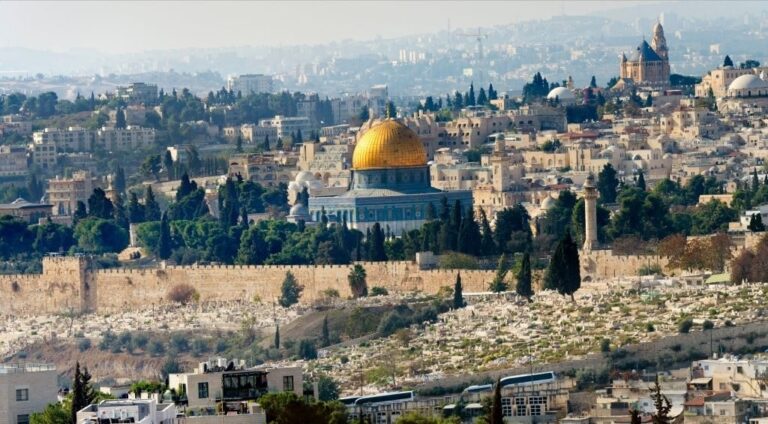History of the Holy Land
Conflict in Palestine is about so much more than simply who was there first.
By: GenZ Staff | November 6, 2023 | 990 Words

(Photo by: Planet One Images/UCG/Universal Images Group via Getty Images)
Israel’s war against Hamas may be a relatively new development, but the area known as Palestine has seen conflict for thousands of years. It’s easy today to oversimplify the reasons behind the fighting and assume it’s all about which side – Arabic Muslim or Israeli Jew – held the area first. To understand what makes this region so important to all three of the world’s largest monotheistic religions (Judaism, Islam, and Christianity), one must understand the history of the Holy Land.
In the Beginning
What has become the Holy Land to Christians, Jews, and Muslims was once called Canaan and was occupied by Canaanites. Today, what used to be Canaan encompasses Israel, the West Bank, Gaza, Jordan, and the southern parts of both Lebanon and Syria. The Canaanites were polytheistic, meaning they worshiped multiple gods.
The names Canaan and Canaanite both appear in non-religious writings from as far back as 15th century BC. According to Jewish scripture, however – more commonly known as the Old Testament to Christians – God promised this land to the descendants of Abraham.

Abraham and Isaac (Photo by Fine Art Images/Heritage Images/Getty Images)
Flash forward to about the year 1000 BC. Abraham’s descendants are organized into the 12 tribes of Israel, named for the 12 sons of Israel, who was Abraham’s grandson. The Israelites had been slaves in Egypt, but they were led away by Moses, who took them in search of the land promised to their ancestor, Abraham, by God.
Eventually, the Israelites entered the promised land – Canaan – where they fought the Canaanites and Philistines. It is because of that latter group that the Greeks called the land Palaistī́nē, which became the Latin Palaestīna while under Roman control, and eventually the English Palestine we’re used to seeing today. Eventually, the 12 tribes conquered the Canaanites and Philistines and united under King David. Since David was from the tribe of Judah, it became the kingdom of Judah. It was David’s son, Solomon, who built the Temple in Jerusalem about 40 years later.
Fighting for the Holy Land
After Solomon’s death, the kingdom split into the southern kingdom of Judah, with Jerusalem as the capital, and the northern kingdom of Israel, with the capital being Samaria. By the time Muhammad, the founder of Islam, was born in AD 570, the Jewish kingdoms of Israel and Judah had been conquered multiple times, with the people being sent into exile four additional times. Rome held the Holy Land by this time in history, and had for about a couple hundred years been a Christian empire. The population then of Israel and the surrounding areas would have been Christians, some Jews, and even some people who worshiped the many Roman gods.
 Islam, though, was rooted in Judaism and Christianity, so the Muslims revered many of the same historical figures and locations as the other two religions. In AD 638 – just five years after the death of Muhammad – Muslims conquered Jerusalem and the surrounding areas from the Roman Empire. This was the first Muslim occupation of the Holy Land. Initially, they allowed Christians and Jews to live there as a special protected class, so long as they paid a special tax. Eventually, however, they were subjected to increased taxes and stricter rules for public behavior, and many began to leave.
Islam, though, was rooted in Judaism and Christianity, so the Muslims revered many of the same historical figures and locations as the other two religions. In AD 638 – just five years after the death of Muhammad – Muslims conquered Jerusalem and the surrounding areas from the Roman Empire. This was the first Muslim occupation of the Holy Land. Initially, they allowed Christians and Jews to live there as a special protected class, so long as they paid a special tax. Eventually, however, they were subjected to increased taxes and stricter rules for public behavior, and many began to leave.
From 1095 to 1102, Christian forces from Western European kingdoms fought in what we now call the First Crusade to retake the Holy Land from Muslim control. Jerusalem itself was captured in the summer of 1099. This Christian control, however, was short lived. In 1187, Saladin, the Sultan of Egypt and Syria, who had united the core of the Islamic Empire, managed to retake Jerusalem and, eventually, the rest of Palestine.
Further Crusades saw Christians in control of some parts of the Holy Land for a time, but not for long, and never the prized city of Jerusalem.
Britain, the UN, and the Two-State Failure
After World War I, the League of Nations (which later became the United Nations) placed the region of Palestine and several other territories taken from the Ottoman Empire (which was a Muslim empire) and gave them to the United Kingdom to control. All but Palestine eventually became fully independent states.
The British Mandate incorporated the Balfour Declaration of 1917, which supported the establishment of a national home for the Jewish people inside Palestine. From 1922 to 1947, Jews from around the world – though mostly from Eastern Europe – migrated to the region, many of whom were fleeing Nazi persecution.
In 1948, an attempt at partitioning the land into two independent states failed, resulting in the establishment of Israel as a nation the West Bank and Gaza falling under Jordanian and Egyptian rule, respectively. The UN’s partition plan, called US Resolution 181, came as the UK prepared to withdraw from the region. It would have divided Palestine into an Arab nation and a Jewish nation, with the Palestinians gaining more land than the Israelis. It would have made Jerusalem a special international city, open to both peoples.
Israel agreed to the plan, but Palestinian leadership rejected it, launching a war against Israel instead. At By the end of the Arab-Israeli War, Israel had occupied more land than originally granted by the plan. This cycle of Israel agreeing to a plan that favors Palestine, only for Palestinian leaders to reject it, launch a war, and end up losing more land in the process continued through multiple more attempts, all the way through the failed two-state solution President Bill Clinton hoped to achieve in 1993.
Throughout the more recent history of the Holy Land, extreme anti-Jewish Palestinian leaders have refused to accept any deal that recognizes Israel as a Jewish state and a legitimate nation. The current war between Israel and Hamas, the Islamic terror group that took over Palestine in 2006, is just a continuation of that centuries-old conflict.
















